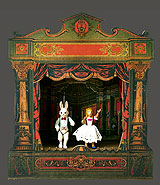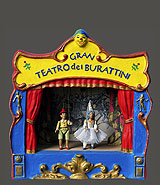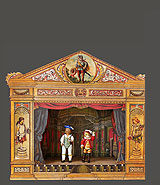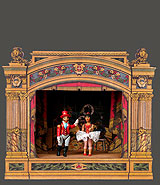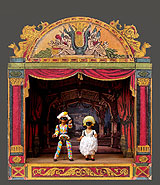The Marionettes: their origins
The marionette and puppet theatre represents one of the greatest cultural traditions of Italy: it brings together the tradition of the Commedia dell’Arte, the contribution of Opera, Romantic drama, ballet as well as the contemporary experimental theatre. Marionettes are of ancient origins: the first ones were actually sacred images and they came from ancient Egypt and India. However, the real marionettes appeared later on in Italy, in Venice precisely: they were animated little figures that miniaturised big wooden statues called “Marione”. These were carried in procession by the people in memory of the saving of several young Venetian brides who had been kidnapped in 944 A.D.
During the Renaissance, these little figures improved thanks to the interest of many artists, travellers and scholars and they were often used, together with puppets, by merchants in order to attract the clients’ attention and draw them near the merchandise. In the seventeenth century, puppets and marionettes became the protagonists of real shows. Marionettes reproduce the whole of the human form, whereas puppets appear half-length and they are hand-operated from under the stage. The puppet theatre repertoire was mainly based on laugh-provoking gags and on the art of improvisation. Puppets were characterised by their liveliness, sometimes accompanied by coarse language, and by their popular quality which followed the farce scheme: the public laughed heartily and the gags typically finished with the characters flogging each other with sticks. Puppeteers were the spokesmen of the feelings and disappointment of the oppressed people: their fierce critique did not spare the mighty few, which explains why they often ended up in prison. The marionette theatre, by contrast, was addressed to a public that included both the people and the well-learnt: their shows were a miniature reproduction of the repertoire of the best theatres, including the Commedia dell’Arte and operetta. Many masks of the Commedia dell’Arte entered the puppet and marionette theatres as main characters: the best known are Arlecchino, Brighella, Colombina, Pantalone and Pulcinella. The puppet theatre masks always displayed a certain aggressiveness, whereas those from the marionette theatre went through an evolution and became more and more gentle as far as the language and behaviour were concerned. New characters without mask emerged after the French Revolution: most of them were especially contorted as being from a particular region. Examples include Gianduja, Gioppino, Sandrone and many others. In the nineteenth century, marionettes enjoyed such success in Europe that new repertory theatres were built in many towns, to join the already well-established strolling companies. In the twentieth century, the technique and the improvisation art of the puppets resisted, in spite of the competition from the cinema and the television. This art was handed down from father to son and it received support from some European countries, in the form of promotion of conferences, marionette player and puppeteer festivals, and making of new theatres to continue this ancient artistic tradition.
COMMEDIA DELL'ARTE "BIG MARIONETTES"
COMMEDIA DELL'ARTE "MICRO MARIONETTES"
TALES "BIG MARIONETTES"
TALES "MICRO MARIONETTES"
BIG POEMS "BIG MARIONETTES"
CIRCUS " MICRO MARIONETTES"
WOODEN SHAPES "BIG MARIONETTES"
WOODEN SHAPES "MICRO MARIONETTES"
